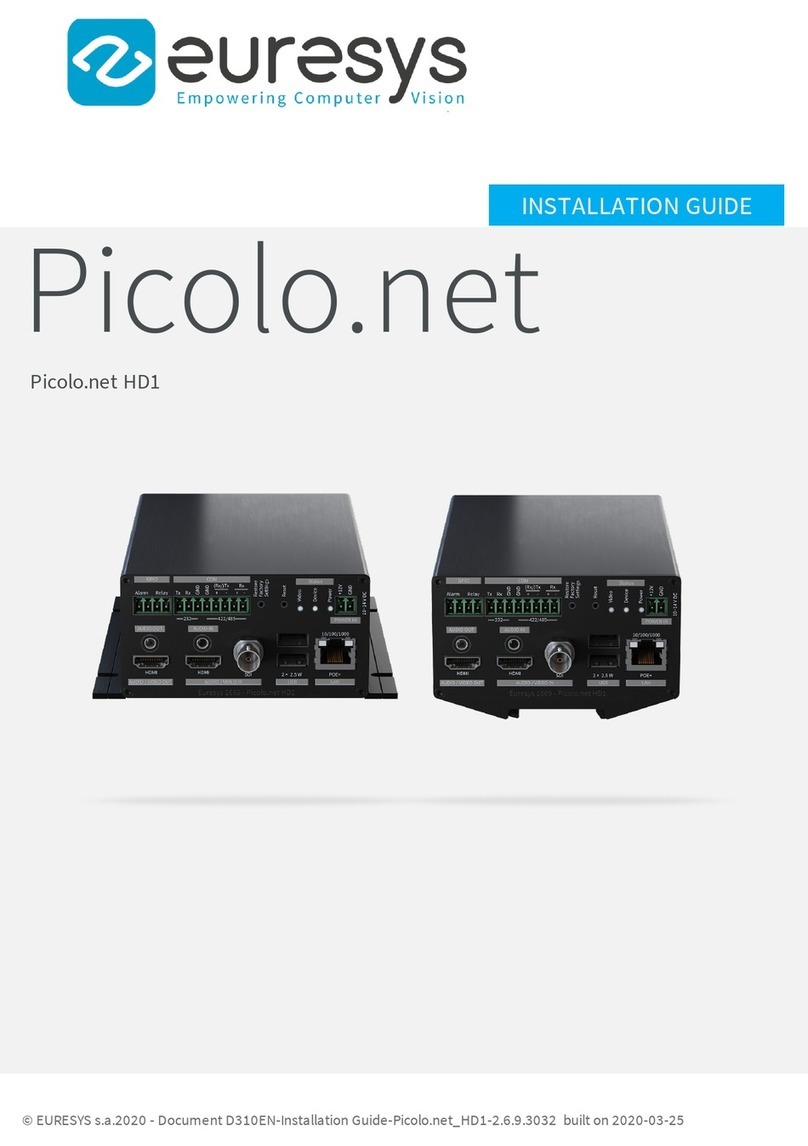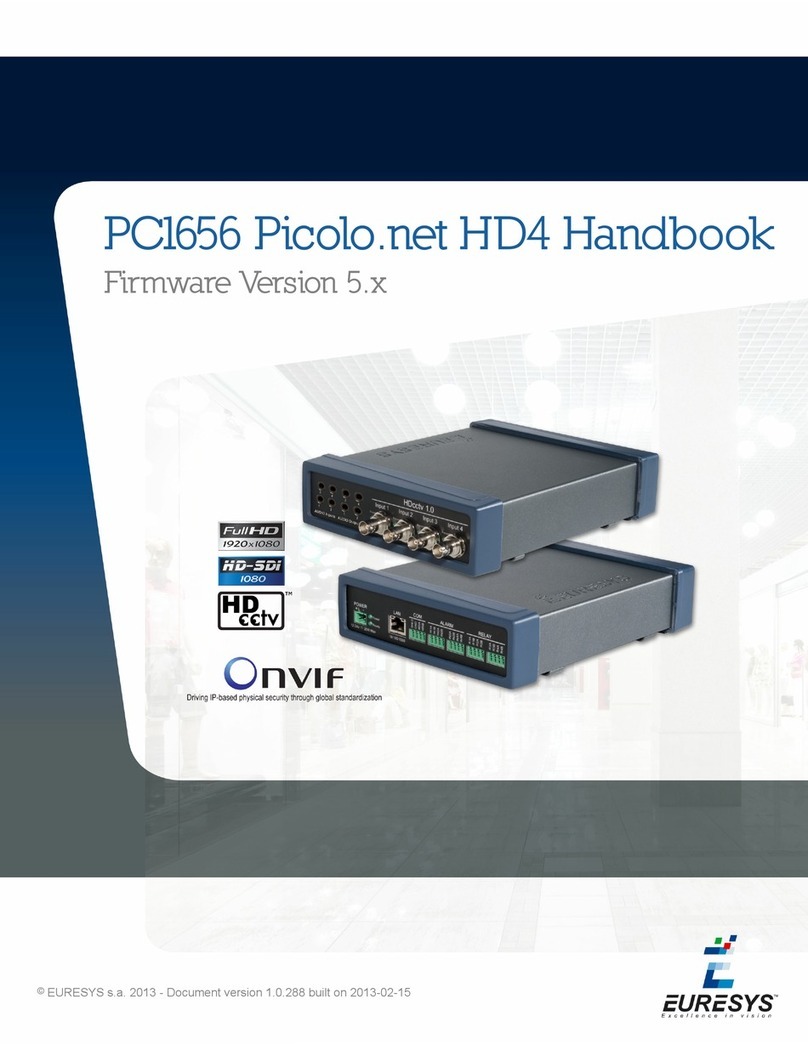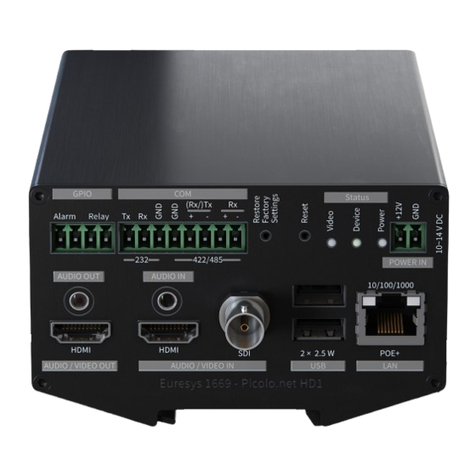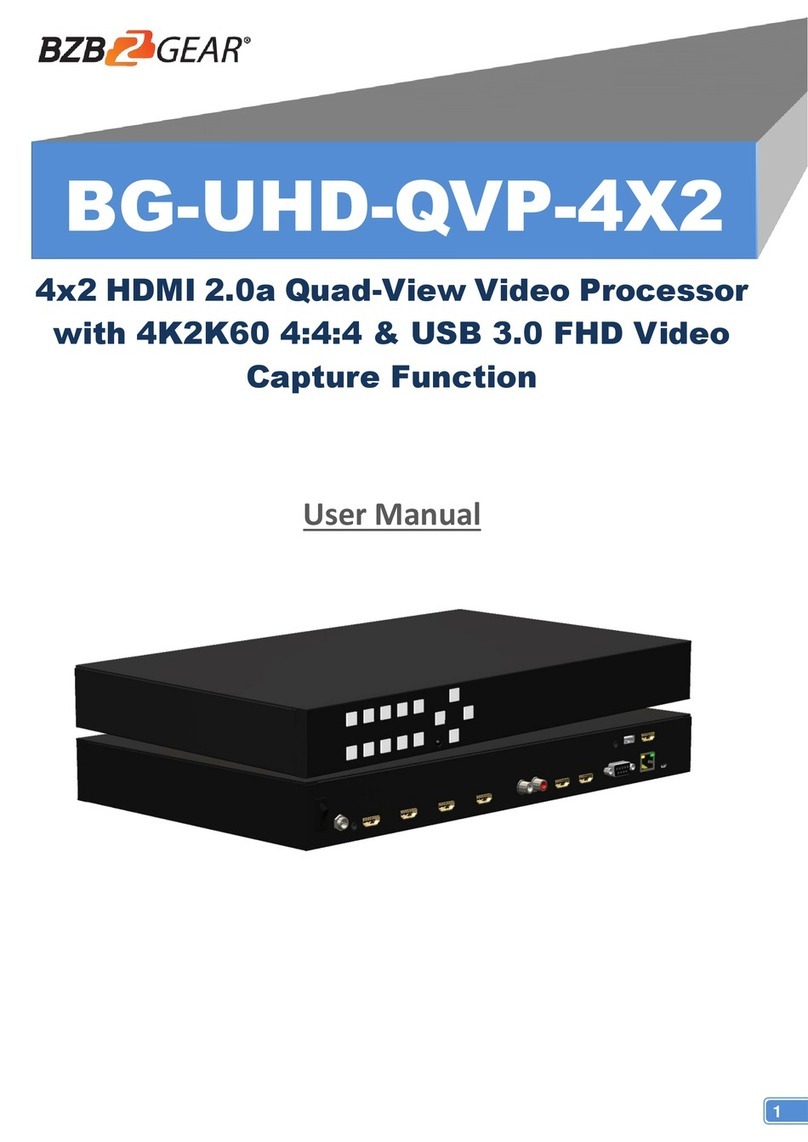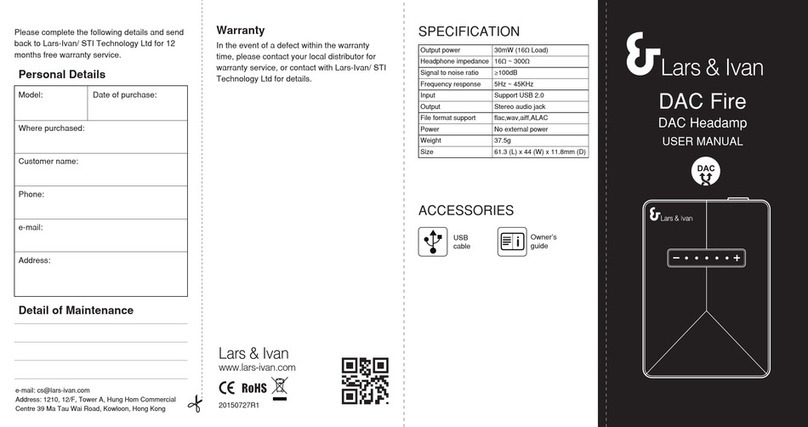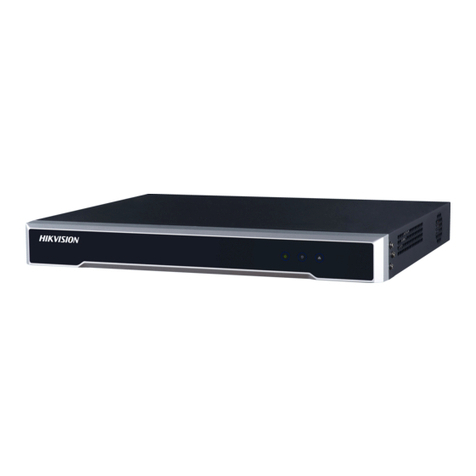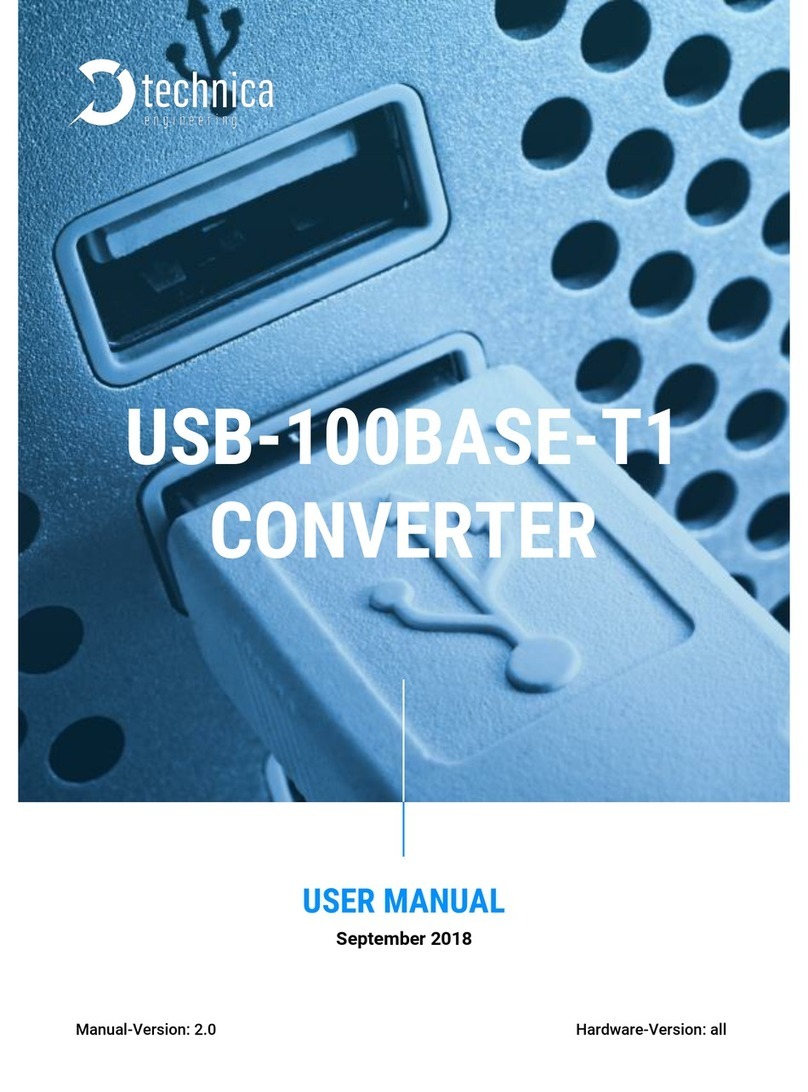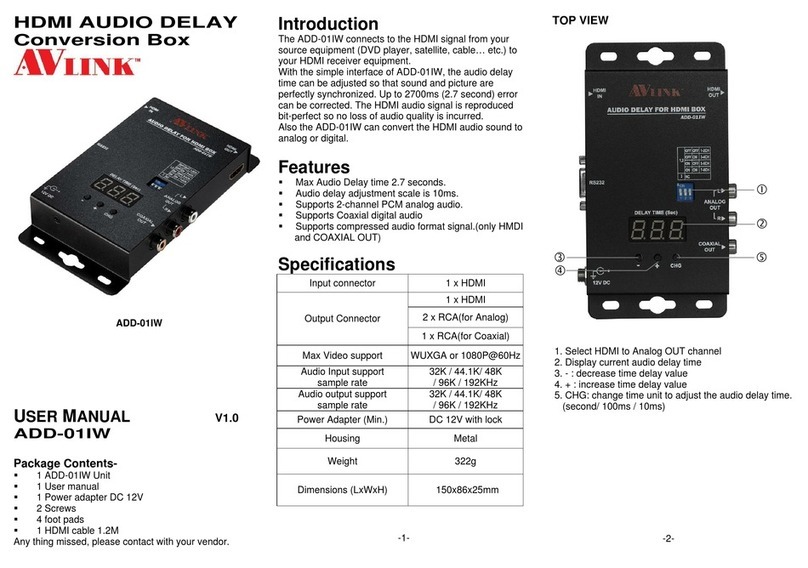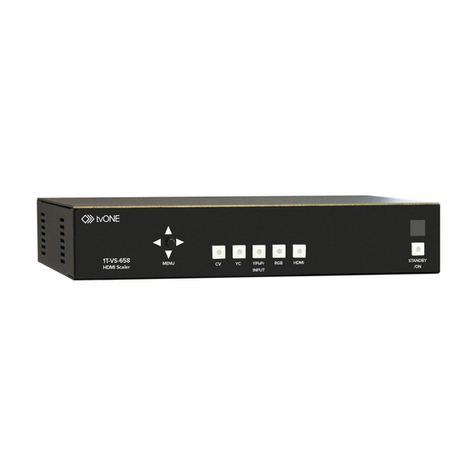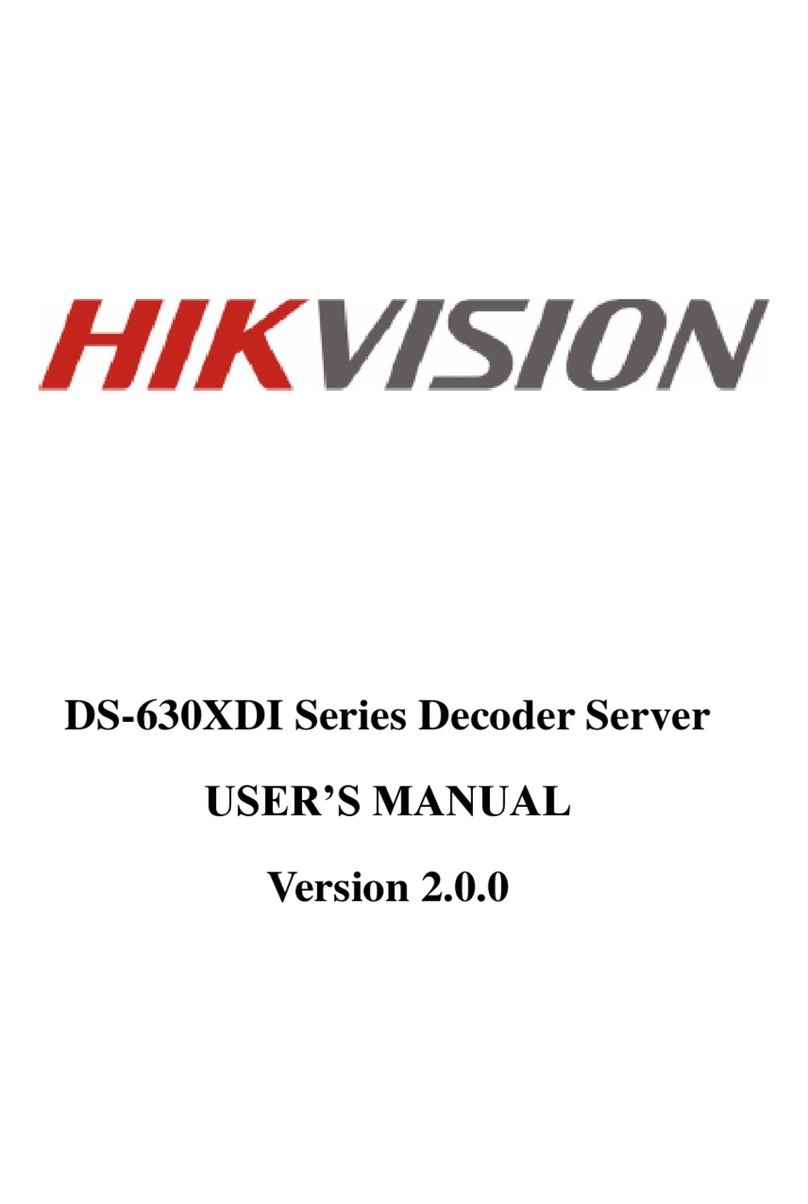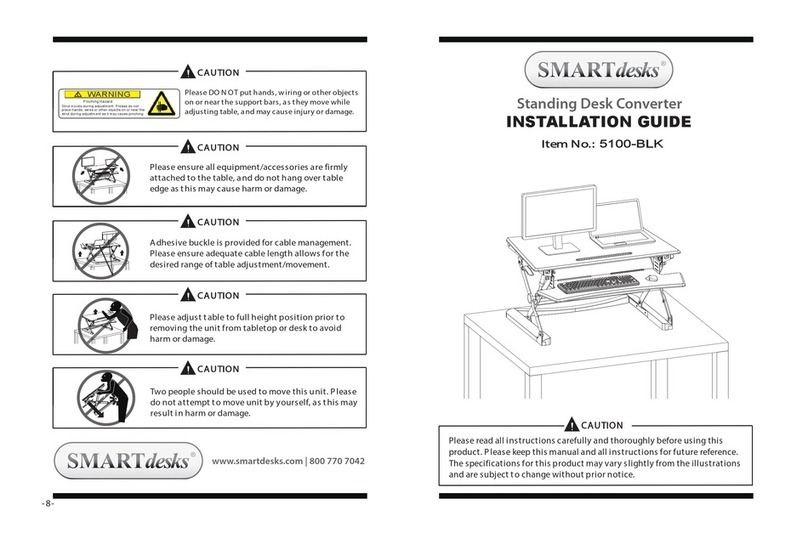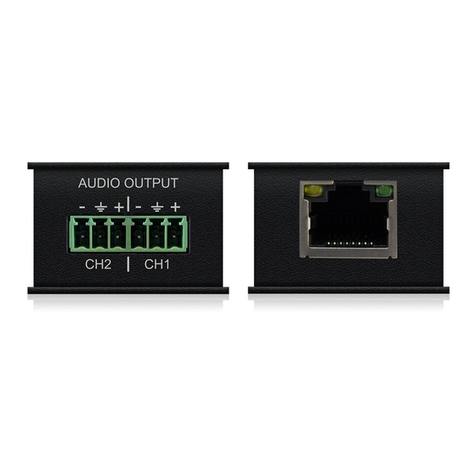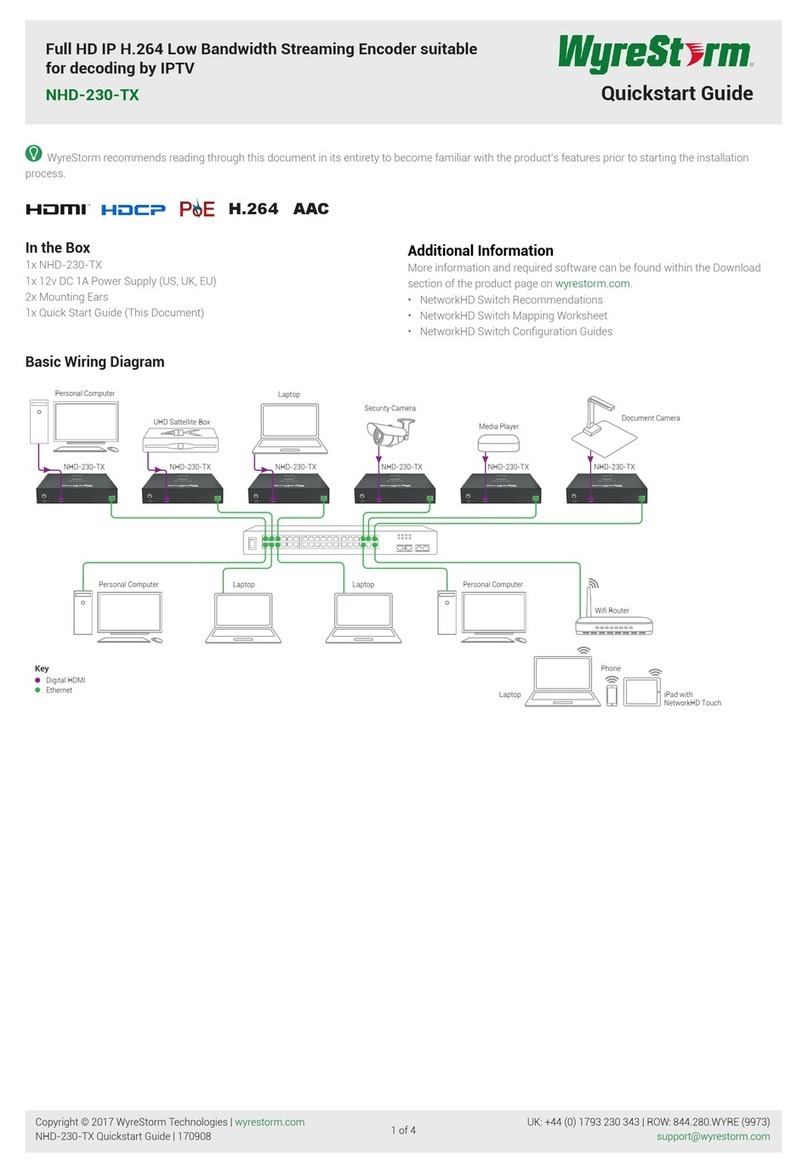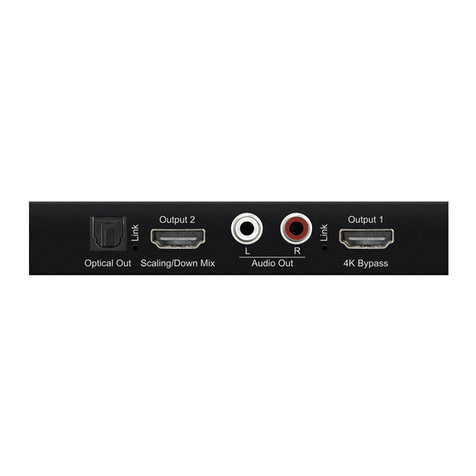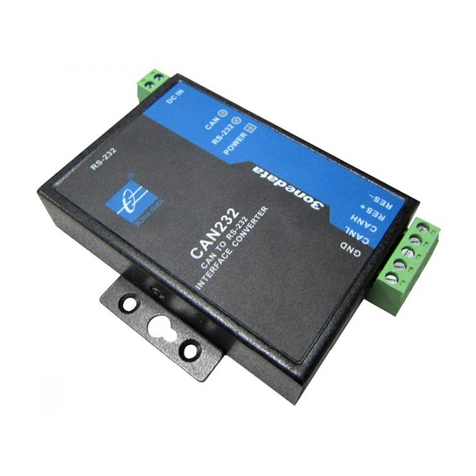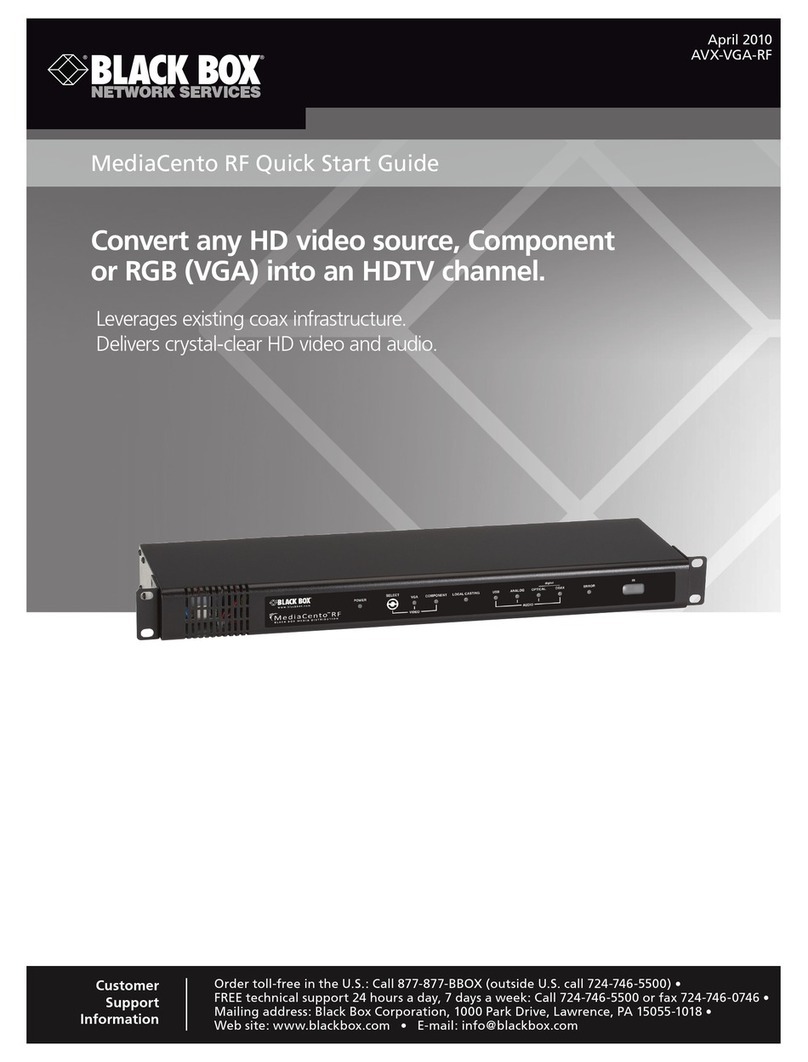Euresys Coaxlink Series Manual

Coaxlink
Coaxlink Driver Version 9.5.2
PROGRAMMER GUIDE
© EURESYS s.a. 2018 - Document D204EN-Programmer Guide-Coaxlink-9.5.2.2015 built on 2018-03-28

2
Terms of Use
EURESYS s.a. shall retain all property rights, title and interest of the documentation of the hardware and the
software, and of the trademarks of EURESYS s.a.
All the names of companies and products mentioned in the documentation may be the trademarks of their
respective owners.
The licensing, use, leasing, loaning, translation, reproduction, copying or modification of the hardware or the
software, brands or documentation of EURESYS s.a. contained in this book, is not allowed without prior notice.
EURESYS s.a. may modify the product specification or change the information given in this documentation at any
time, at its discretion, and without prior notice.
EURESYS s.a. shall not be liable for any loss of or damage to revenues, profits, goodwill, data, information systems or
other special, incidental, indirect, consequential or punitive damages of any kind arising in connection with the use
of the hardware or the software of EURESYS s.a. or resulting of omissions or errors in this documentation.
This documentation is provided with Coaxlink 9.5.2 (doc build 2015).
© 2018 EURESYS s.a.
Coaxlink Programmer Guide

3
Contents
1. Introduction 5
2. GenApi 6
3. GenTL 8
3.1. System module 9
3.2. Interface module 9
3.3. Device module 9
3.4. Data stream module 10
3.5. Buffer module 10
3.6. GenTL API 10
4. Euresys::EGenTL 11
4.1. A first example 12
4.2. Relevant files 13
5. Euresys::EGrabber 14
5.1. A first example 15
5.2. Acquiring images 16
5.3. Configuring the grabber 18
5.4. Events 20
Background 20
Counters 21
Notifications 21
Callback functions 22
Event identification 23
Examples 24
5.5. EGrabber flavors 24
5.6. Events and callbacks examples 26
On demand callbacks 26
Single thread and multi thread callbacks 28
New buffer callbacks 29
5.7. Relevant files 30
Coaxlink Programmer Guide

4
6. Euresys GenApi scripts 31
6.1. doc/basics.js 31
6.2. doc/builtins.js 37
6.3. doc/grabbers.js 38
6.4. doc/module1.js 40
7. EGrabber for MultiCam users 42
8. .NET assembly 49
8.1. A first example 49
8.2. Differences between C++ and .NET EGrabber 50
8.3. Single thread callbacks 51
9. Definitions 53
Coaxlink Programmer Guide

5
1. Introduction
The Application Programming Interface (API) for Coaxlink cards is based on GenICam.
The goal of GenICam is to provide a standardized, uniform programming interface for using
cameras and frame grabbers based on different physical interfaces (CoaXPress, GigE Vision, etc.)
or from different vendors.
GenICam is a set of EMVA standards (GenApi and GenTL), as well as related conventions for
naming things (the SFNC for standard features, the PFNC for pixel formats).
nGenApi is about description. At the core of GenApi is the concept of register description.
Register descriptions are provided in the form of XML files. They map low-level hardware
registers to high-level features.
GenApi allows applications to detect, configure and use the features of cameras and frame
grabbers in a uniform and consistent way.
nGenTL is about data transport. The TL suffix stands for Transport Layer.
The GenTL standard defines a set of C functions and data types for enumerating, configuring,
and grabbing images from cameras and frame grabbers. This API is defined by a C header file.
Frame grabber vendors provide libraries that implement this API (i.e., libraries that export the
functions declared in the standard header file). These libraries are referred to as GenTL
producers, or Common Transport Interfaces (CTI) and use the cti file extension. The GenTL
producer for Coaxlink cards is coaxlink.cti.
This document is meant to be read from beginning to end. Each chapter and section builds
upon the preceding ones. If you skip parts of the text, some of the explanations and examples
may seem cryptic. If that happens, you should go back and read the parts that you've skipped
over.
1. Introduction Coaxlink Programmer Guide

6
2. GenApi
GenApi addresses the problem of configuring cameras. The way this is achieved is generic, and
applies to different kinds of devices, including frame grabbers. In this chapter, everything we say
about cameras also applies to frame grabbers.
GenApi requires two things to work: a register description, and a GenApi implementation.
Register description
Aregister description is an XML file that can be thought of as a computer-readable datasheet of
the camera. It defines camera settings (such as PixelFormat and TriggerSource), and
instructions on how to configure them (e.g., to set ExposureMode to Timed, write value 0x12 to
register 0xE0140). It can also contain camera documentation.
GenApi implementation
AGenApi implementation is a software module that can read and interpret register description
files.
The EMVA provides a reference implementation, but it is fairly difficult to use, and logging is
very poor. Instead, we recommend using the Euresys implementation bundled with the Coaxlink
software package. This implementation also allows writing powerful configuration scripts.
Features
What the user gets from GenApi is a bunch of named features, organized in categories.
Set/get features
Set/get features are simple settings (called parameters in MultiCam), and can be of different
types:
ninteger (e.g., Width)
nfloat (e.g., AcquisitionFrameRate)
nenumeration (e.g., PixelFormat)
nboolean (e.g., LUTEnable)
nstring (e.g., DeviceVendorName)
The value of features can be retrieved/modified using get/set functions. Some features are read-
only and some are write-only, but most allow read/write access.
Coaxlink Programmer Guide 2. GenApi

7
Commands
There is also another kind of features: commands (e.g., AcquisitionStart). Commands are
special: they don't have any associated value; they have side effects. Command features are
meant to be executed. When a command is executed, some action happens in the camera (e.g.,
a software trigger is generated). Obviously, get/set functions don't make sense for commands
and can't be used.
2. GenApi Coaxlink Programmer Guide

8
3. GenTL
GenTL defines 5 types of objects, organized in a parent/child relationship:
1. the system module
2. the interface module
3. the device module
4. the data stream module
5. the buffer module
Each module:
●corresponds to a particular element of the system;
●defines relevant pieces of information (info commands) that can be queried (using get info
functions);
●allows exercising that module's functionality (using specific functions).
Additionally, all modules except the buffer module behave as ports that allow read/write
operations. These port functions are used by GenApi to load that module's description file, and
to use its GenApi features.
GenTL Module Hierarchy
Coaxlink Programmer Guide 3. GenTL

9
3.1. System module
The system module (also referred to as TLSystem), represents the GenTL producer (the
coaxlink.cti library). This module is at the top of the parent/child tree.
The system module provides basic information about the GenTL producer: things like the
complete path to coaxlink.cti and the vendor name (Euresys).
The real point of the system module is to list the interfaces (or frame grabbers) present in the
system. The most important functions of the system module are TLGetNumInterfaces (to
retrieve the number of frame grabbers in the system) and TLOpenInterface (to get access to
one of the frame grabbers).
3.2. Interface module
The GenTL standard calls frame grabbers interfaces. The system module has one child interface
for each frame grabber: if there are 2 Coaxlink cards in the computer, the system module will
have two child interfaces.
Each interface represents a frame grabber. Global frame grabber features such as digital I/O
lines belong in the interface module. This means that the GenApi features controlling the I/O
lines are attached to the interface.
Each interface also acts as parent to one or several devices. The most important functions of the
interface module are IFGetNumDevices (to retrieve the number of cameras that can be
connected to the interface) and IFOpenDevice (to get access to one of the devices).
3.3. Device module
The GenTL standard uses the terms device and remote device for two related but different
concepts. A remote device is a real camera, physically connected to a frame grabber. This is
different from the device module we describe here.
The device module is the module that contains the frame grabber settings relating to the
camera. This includes things like triggers and strobes.
The device module also acts as parent to one data stream, and can be viewed as the sibling of
the remote device. The most important functions of the device module are DevOpenDataStream
(to get access to the data stream) and DevGetPort (to get access to the remote device).
3. GenTL Coaxlink Programmer Guide

10
3.4. Data stream module
The data stream module handles buffers. During acquisition runs, images are sent from the
camera to the frame grabber, which transfers them to memory buffers allocated on the host
computer. The data stream module is where image acquisition occurs. It is where most of the
functionality resides.
Buffer handling is very flexible. Any number of buffers can be used. Buffers are either in the input
queue, in the output queue, or temporarily unqueued. The application decides when empty
buffers are queued (to the input FIFO), and when filled buffers are popped (from the output
FIFO).
3.5. Buffer module
The buffer module simply represents a memory buffer given to a parent data stream. Useful
metadata is associated to buffers. This includes the image width, height, pixel format,
timestamp... These are retrieved through info commands (see BUFFER_INFO_CMD_LIST in the
standard GenTL header file).
The buffer module is the only module that doesn't have read/write port functions; it doesn't
have GenApi features.
3.6. GenTL API
GenTL makes it possible to detect, control and use all camera and frame grabber features, but
its usage is tedious:
ncti files must be dynamically loaded, and the functions they export must be accessed
through pointers.
nFunctions return an error code that must be checked by the application.
nMost functions read from/write to untyped buffers: the application must determine the
required buffer size, allocate a temporary buffer, convert data to/from this buffer, and finally
release the buffer memory.
Instead of using the GenTL API directly, we recommend using either:
nthe Euresys::EGenTL library which deals with these complications so that the user doesn't
have to;
nor the Euresys::EGrabber library which provides a high-level, easy-to-use interface.
Coaxlink Programmer Guide 3. GenTL

11
4. Euresys::EGenTL
Euresys::EGenTL is a library of C++ classes that provide the same functionality as standard
GenICam GenTL, but with a more user-friendly interface. For example, it uses std::string
instead of raw char pointers, and error codes are transformed into exceptions.
Euresys::EGenTL also takes care of locating the GenTL producer and loading the functions it
exports.
This library is implemented entirely in C++ header files. As a result, you can simply include the
relevant header file:
#include <EGenTL.h>
Instead of the raw, low-level C functions that GenTL defines, we get a Euresys::EGenTL object
that represents the GenTL producer:
nEach GenTL function is available as a member method of Euresys::EGenTL. GenTL function
names start with an upper-case prefix. In Euresys::EGenTL, method names start with the
same prefix, but written in lower-case. For example, the GCReadPort function is exposed as
the gcReadPort method, and the TLOpenInterface function as the tlOpenInterface
method.
nAll GenTL functions return a GC_ERROR code indicating success or failure. When a function
returns a code other than GC_ERR_SUCCESS, an exception is thrown. This removes the
burden of manually checking error codes after each function call.
nSince GenTL functions return a GC_ERROR, output values are returned through pointers
passed as arguments. Euresys::EGenTL methods offer a more natural interface; they return
the output value directly:
GC_API TLGetNumInterfaces(TL_HANDLE hTL, uint32_t *piNumIfaces);
uint32_t tlGetNumInterfaces(TL_HANDLE tlh);
(Note that GC_API is defined as GC_IMPORT_EXPORT GC_ERROR GC_CALLTYPE. It is simply a
GC_ERROR decorated with calling convention and DLL import/export attributes.)
nFor GenTL functions that deal with text, the corresponding Euresys::EGenTL methods
convert from char * to std::string and vice-versa:
GC_API TLGetInterfaceID(TL_HANDLE hTL, uint32_t iIndex,
char *sID, size_t *piSize);
std::string tlGetInterfaceID(TL_HANDLE tlh, uint32_t index);
4. Euresys::EGenTL Coaxlink Programmer Guide

12
nSome GenTL functions retrieve information about the camera or frame grabber. These
functions fill a void * buffer with a value, and indicate in an INFO_DATATYPE the actual
type of the value. Euresys::EGenTL uses C++ templates to make these functions easy to
use:
GC_API GCGetInfo(TL_INFO_CMD iInfoCmd, INFO_DATATYPE *piType,
void *pBuffer, size_t *piSize);
template<typename T> T gcGetInfo(TL_INFO_CMD cmd);
4.1. A first example
This program uses Euresys::EGenTL to iterate over the Coaxlink cards present in the system,
and display their id:
#include <iostream>
#include <EGrabber.h>
// 1
static const uint32_t CARD_IX = 0;
static const uint32_t DEVICE_IX = 0;
void showInfo() {
Euresys::EGenTL gentl;
// 2
Euresys::EGrabber<> grabber(gentl, CARD_IX, DEVICE_IX);
// 3
std::string card = grabber.getString<Euresys::InterfaceModule>("InterfaceID");
// 4
std::string dev = grabber.getString<Euresys::DeviceModule>("DeviceID");
// 5
int64_t width = grabber.getInteger<Euresys::RemoteModule>("Width");
// 6
int64_t height = grabber.getInteger<Euresys::RemoteModule>("Height");
// 6
std::cout << "Interface: " << card << std::endl;
std::cout << "Device: " << dev << std::endl;
std::cout << "Resolution: " << width << "x" << height << std::endl;
}
int main() {
try {
// 7
showInfo();
} catch (const std::exception &e) {
// 7
std::cout << "error: " << e.what() << std::endl;
}
}
Coaxlink Programmer Guide 4. Euresys::EGenTL

13
1. Include EGenTL.h, which contains the definition of the Euresys::EGenTL class.
2. Create a Euresys::EGenTL object. This involves the following operations:
nlocate and dynamically load the Coaxlink GenTL producer (coaxlink.cti);
nretrieve pointers to the functions exported by coaxlink.cti, and make them available
via Euresys::EGenTL methods;
ninitialize coaxlink.cti (this is done by calling the GenTL initialization function
GCInitLib).
3. Open the GenTL producer. This returns a handle of type GenTL::TL_HANDLE. The GenTL
namespace is defined in the standard GenTL header file, which has been automatically
included by EGenTL.h in step 1.
4. Find out how many cards are present in the system.
5. Retrieve the id of the n-th card.
6. Euresys::EGenTL uses exceptions to report errors, so we wrap our code inside a try ...
catch block.
Example of program output:
[0] PC1633 - Coaxlink Quad G3 (1-camera, line-scan) - KQG00014
[1] PC1632 - Coaxlink Quad (1-camera) - KQU00031
4.2. Relevant files
include/EGenTL.h
Main header. Includes all the other headers. Defines Euresys::EGenTL
include/GenTL_v1_5.h
Standard GenTL header. Defines standard types, functions and constants.
include/GenTL_v1_5_EuresysCustom.h
Defines Coaxlink-specific constants
4. Euresys::EGenTL Coaxlink Programmer Guide

14
5. Euresys::EGrabber
Euresys::EGrabber is a library of C++ classes that provide a high-level interface. It is built on
top of the Euresys::EGenTL library, and is recommended for most users.
A .NET assembly, built on top of the Euresys::EGrabber C++ classes, is also provided. In this
document, we focus mainly on the C++ API. Minor differences between the C++ and .NET
interfaces are listed in a dedicated chapter.
To use the classes described here, you need to include the main Euresys::EGrabber file:
#include <EGrabber.h>
Euresys::EGrabber is a header-only library (it isn't provided as a lib or dll file). It
comprises several classes, the most important of which is also named Euresys::EGrabber:
namespace Euresys {
class EGrabber;
}
In this text, we'll refer to this class as a grabber. A grabber encapsulates a set of related GenTL
modules:
nAn interface: the module that represents global (shared) frame grabber settings and features.
This includes digital I/O control, PCIe and firmware status...
nA device (or local device, as opposed to remote device): the module that contains the frame
grabber settings and features relating to the camera. This consists mainly of camera and
illumination control features: strobes, triggers...
nA data stream: the module that handles image buffers.
nA remote device: the CoaXPress camera.
nA number of buffers.
Go back to the chapter about GenTL modules if these concepts are not clear.
Coaxlink Programmer Guide 5. Euresys::EGrabber

15
5.1. A first example
This example creates a grabber and displays basic information about the interface, device, and
remote device modules it contains:
#include <iostream>
#include <EGrabber.h>
// 1
static const uint32_t CARD_IX = 0;
static const uint32_t DEVICE_IX = 0;
void showInfo() {
Euresys::EGenTL gentl;
// 2
Euresys::EGrabber<> grabber(gentl, CARD_IX, DEVICE_IX);
// 3
std::string card = grabber.getString<Euresys::InterfaceModule>("InterfaceID");
// 4
std::string dev = grabber.getString<Euresys::DeviceModule>("DeviceID");
// 5
int64_t width = grabber.getInteger<Euresys::RemoteModule>("Width");
// 6
int64_t height = grabber.getInteger<Euresys::RemoteModule>("Height");
// 6
std::cout << "Interface: " << card << std::endl;
std::cout << "Device: " << dev << std::endl;
std::cout << "Resolution: " << width << "x" << height << std::endl;
}
int main() {
try {
// 7
showInfo();
} catch (const std::exception &e) {
// 7
std::cout << "error: " << e.what() << std::endl;
}
}
1. Include EGrabber.h, which defines the Euresys::EGrabber class, and includes the other
header files we need (such as EGenTL.h and the standard GenTL header file).
2. Create a Euresys::EGenTL object. This involves the following operations:
nlocate and dynamically load the Coaxlink GenTL producer (coaxlink.cti);
nretrieve pointers to the functions exported by coaxlink.cti, and make them available
via Euresys::EGenTL methods;
ninitialize coaxlink.cti (this is done by calling the GenTL initialization function
GCInitLib).
3. Create a Euresys::EGrabber object. The constructor needs the gentl object created in
step 2. It also takes as optional arguments the indices of the interface and device to use.
The purpose of the angle brackets (<>) that come after EGrabber will become clear later. For
now, they can be safely ignored.
5. Euresys::EGrabber Coaxlink Programmer Guide

16
4. Use "GenApi" on page6 to find out the ID of the Coaxlink card.
Euresys::InterfaceModule indicates that we want an answer from the interface module.
5. Similarly, find out the ID of the device. This time, we use Euresys::DeviceModule to target
the device module.
6. Finally, read the camera resolution. Euresys::RemoteModule indicates that the value must
be retrieved from the camera.
7. Euresys::EGrabber uses exceptions to report errors, so we wrap our code inside a try
... catch block.
Example of program output:
Interface: PC1633 - Coaxlink Quad G3 (2-camera) - KQG00014
Device: Device0
Resolution: 4096x4096
5.2. Acquiring images
This program uses Euresys::EGrabber to acquire images from a camera connected to a
Coaxlink card:
#include <iostream>
#include <EGrabber.h>
void grab() {
Euresys::EGenTL gentl;
Euresys::EGrabber<> grabber(gentl); // 1
grabber.reallocBuffers(3); // 2
grabber.start(10); // 3
for (size_t i = 0; i < 10; ++i) {
Euresys::ScopedBuffer buf(grabber); // 4
void *ptr = buf.getInfo<void *>(GenTL::BUFFER_INFO_BASE); // 5
uint64_t ts = buf.getInfo<uint64_t>(GenTL::BUFFER_INFO_TIMESTAMP); // 6
std::cout << "buffer address: " << ptr << ", timestamp: "
<< ts << " us" << std::endl;
} // 7
}
int main() {
try {
grab();
} catch (const std::exception &e) {
std::cout << "error: " << e.what() << std::endl;
}
}
1. Create a Euresys::EGrabber object. The second and third arguments of the constructor
are omitted here. The grabber will use the first device of the first interface present in the
system.
2. Allocate 3 buffers. The grabber automatically determines the required buffer size.
Coaxlink Programmer Guide 5. Euresys::EGrabber

17
3. Start the grabber. Here, we ask the grabber to fill 10 buffers. If we don't want the grabber to
stop after a specific number of buffers, we can do grabber.start(GenTL::GENTL_
INFINITE), or simply grabber.start().
Starting the grabber involves the following operations:
nthe AcquisitionStart command is executed on the camera;
nthe DSStartAcquisition function is called to start the data stream.
In this example, we assume that the camera and frame grabber are properly configured. For
a real application, it would be safer to run a configuration script before starting acquisitions
(and before allocating buffers for that matter). This will be shown in another example.
4. Wait for a buffer filled by the grabber. The result is a Euresys::ScopedBuffer. The term
scoped is used to indicate that the lifetime of the buffer is the current scope (i.e., the current
block).
5. Retrieve the buffer address. This is done by calling the getInfo method of the buffer. This
method takes as argument a BUFFER_INFO_CMD. In this case, we request the BUFFER_INFO_
BASE, which is defined in the standard GenTL header file:
enum BUFFER_INFO_CMD_LIST
{
BUFFER_INFO_BASE = 0, /* PTR Base address of the buffer memory. */
BUFFER_INFO_SIZE = 1, /* SIZET Size of the buffer in bytes. */
BUFFER_INFO_USER_PTR = 2, /* PTR Private data pointer of the GenTL Consumer.
*/
BUFFER_INFO_TIMESTAMP = 3, /* UINT64 Timestamp the buffer was acquired. */
// ...
// other BUFFER_INFO definitions omitted
// ...
BUFFER_INFO_CUSTOM_ID = 1000 /* Starting value for GenTL Producer custom IDs. */
};
typedef int32_t BUFFER_INFO_CMD;
Notice that getInfo is a template method, and when we call it we must specify the type of
value we expect. BUFFER_INFO_BASE returns a pointer; this is why we use getInfo<void
*>.
6. Do the same to retrieve the timestamp of the buffer. This time, we use the uint64_t version
of getInfo to match the type of BUFFER_INFO_TIMESTAMP.
Note that, for Coaxlink, timestamps are always 64-bit and expressed as the number of
microseconds that have elapsed since the computer was started.
7. We reach the end of the for block. The local variable buf gets out of scope and is destroyed:
the ScopedBuffer destructor is called. This causes the GenTL buffer contained in buf to be
re-queued (given back) to the data stream of the grabber.
Example of program output:
buffer address: 0x7f3c32c54010, timestamp: 11247531003686 us
buffer address: 0x7f3c2c4bf010, timestamp: 11247531058080 us
buffer address: 0x7f3c2c37e010, timestamp: 11247531085003 us
buffer address: 0x7f3c32c54010, timestamp: 11247531111944 us
buffer address: 0x7f3c2c4bf010, timestamp: 11247531137956 us
buffer address: 0x7f3c2c37e010, timestamp: 11247531163306 us
buffer address: 0x7f3c32c54010, timestamp: 11247531188600 us
buffer address: 0x7f3c2c4bf010, timestamp: 11247531213807 us
buffer address: 0x7f3c2c37e010, timestamp: 11247531239158 us
buffer address: 0x7f3c32c54010, timestamp: 11247531265053 us
5. Euresys::EGrabber Coaxlink Programmer Guide

18
We can see that the three buffers that were allocated (let's call them A at 0x7f3c32c54010, B
at 0x7f3c2c4bf010, and C at 0x7f3c2c37e010) are used in a round-robin fashion: A → B → C →
A → B → C → ... This is the result of:
nthe FIFO nature of input and output buffer queues:
nthe Coaxlink driver pops a buffer from the front of the input queue, and gives it to the
Coaxlink card for DMA transfer;
nwhen the transfer is complete, the buffer is pushed to the back of the output queue;
nthe use of ScopedBuffer:
nthe ScopedBuffer constructor pops a buffer from the front of the output queue (i.e., it
takes the oldest buffer);
nthe ScopedBuffer destructor pushes that buffer to the back of the input queue (hence,
this buffer will be used for a new transfer after all buffers already in the input queue).
5.3. Configuring the grabber
Configuration is a very important aspect of any image acquisition program.
nThe camera and the frame grabber both have to be configured according to the application
requirements.
nThe camera configuration must be compatible with the frame grabber configuration, and
vice versa.
Configuration basically boils down to a series of set/get operations performed on the grabber
modules: the remote device (i.e., the camera), the interface, the device, or the data stream
modules.
This program configures the grabber for the so-called RG control mode (asynchronous reset
camera control, frame grabber-controlled exposure).
#include <iostream>
#include <EGrabber.h>
const double FPS = 150;
void configure() {
Euresys::EGenTL gentl;
Euresys::EGrabber<> grabber(gentl);
// camera configuration
grabber.setString<Euresys::RemoteModule>("TriggerMode", "On");
// 1
grabber.setString<Euresys::RemoteModule>("TriggerSource", "CXPin");
// 2
grabber.setString<Euresys::RemoteModule>("ExposureMode", "TriggerWidth");
// 3
// frame grabber configuration
grabber.setString<Euresys::DeviceModule>("CameraControlMethod", "RG");
// 4
grabber.setString<Euresys::DeviceModule>("CycleTriggerSource", "Immediate");
// 5
grabber.setFloat<Euresys::DeviceModule>("CycleMinimumPeriod", 1e6 / FPS);
// 6
}
Coaxlink Programmer Guide 5. Euresys::EGrabber

19
int main() {
try {
configure();
} catch (const std::exception &e) {
std::cout << "error: " << e.what() << std::endl;
}
}
1. Enable triggers on the camera.
2. Tell the camera to look for triggers on the CoaXPress link.
3. Configure the camera to use the TriggerWidth exposure mode.
4. Set the frame grabber's camera control method to RG. In this mode, camera cycles are
initiated by the frame grabber, and the exposure duration is also controlled by the frame
grabber.
5. Tell the frame grabber to initiate camera cycles itself (at a rate defined by
CycleMinimumPeriod), without waiting for hardware or software triggers.
6. Configure the frame rate.
But there is a better way to configure the grabber. Using a script file, the program becomes:
#include <iostream>
#include <EGrabber.h>
void configure() {
Euresys::EGenTL gentl;
Euresys::EGrabber<> grabber(gentl);
grabber.runScript("config.js");
}
int main() {
try {
configure();
} catch (const std::exception &e) {
std::cout << "error: " << e.what() << std::endl;
}
}
and the configuration script is:
var grabber = grabbers[0];
var FPS = 150;
// camera configuration
grabber.RemotePort.set("TriggerMode", "On");
grabber.RemotePort.set("TriggerSource", "CXPin");
grabber.RemotePort.set("ExposureMode", "TriggerWidth");
// frame grabber configuration
grabber.DevicePort.set("CameraControlMethod", "RG");
grabber.DevicePort.set("CycleTriggerSource", "Immediate");
grabber.DevicePort.set("CycleMinimumPeriod", 1e6 / FPS);
Using a script file has several advantages:
nThe configuration can be changed without recompiling the application. This allows shorter
development cycles, and makes it possible to update the configuration in the lab or in the
field.
nThe configuration script can be loaded by the GenICam Browser and the command-line
gentl tool. This makes is possible to validate the configuration outside of the user
application.
5. Euresys::EGrabber Coaxlink Programmer Guide

20
nThe configuration script can easily be shared by several applications written in different
programming languages: C++, C#, VB.NET...
nThe full power of Euresys GenApi scripts is available.
5.4. Events
Background
Coaxlink cards generate different kinds of events:
nNew buffer events: events indicating that a buffer has been filled by a data stream.
nData stream events: events related to a data stream and its frame store.
nCamera and illumination controller events: events related to the real-time control (performed
by a device) of a camera and its illumination devices.
nI/O toolbox events: events (coming from the interface) related to digital I/O lines and other I/O
tools.
nCoaXPress interface events: events (also coming from the interface) related to the CoaXPress
interface.
New buffer events are standard in GenTL. They occur when a buffer is filled by the frame
grabber. Information attached to new buffer events include the handle of the buffer and a
timestamp.
The other types of events are restricted to Coaxlink and can be viewed as categories of specific
events. For example, in the CIC category of events, we have:
nCameraTriggerRisingEdge (start of camera trigger)
nCameraTriggerFallingEdge (end of camera trigger)
nStrobeRisingEdge (start of light strobe)
nStrobeFallingEdge (end of light strobe)
nAllowNextCycle (CIC is ready for next camera cycle)
n...
and in the I/O toolbox category of events, we have:
nLIN1 (line input tool 1)
nLIN2 (line input tool 2)
nMDV1 (multiplier/divider tool 1)
n...
Coaxlink Programmer Guide 5. Euresys::EGrabber
Table of contents
Other Euresys Media Converter manuals
